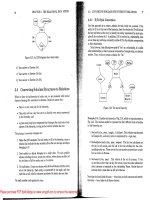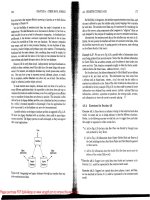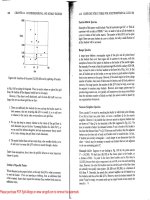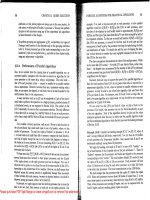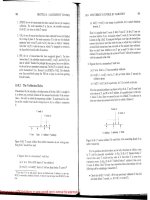699 the druby book
Bạn đang xem bản rút gọn của tài liệu. Xem và tải ngay bản đầy đủ của tài liệu tại đây (6.8 MB, 266 trang )
www.it-ebooks.info
What Readers Are Saying About
The dRuby Book
The dRuby Book is a fantastic introduction to distributed programming in Ruby
for all levels of users. The book covers all aspects of dRuby, including the principles
of distributed programming and libraries and techniques to make your work
easier. I recommend this book for anyone who is interested in distributed programming in Ruby and wants to learn the basics all the way to advanced process
coordination strategies.
➤ Eric Hodel
Ruby committer, RDoc and RubyGems maintainer
dRuby is the key component that liberates Ruby objects from processes and
machine platforms. Masatoshi himself explains its design, features, case studies,
and even more in this book.
➤ Yuki “Yugui” Sonoda
Ruby 1.9 release manager
dRuby naturally extends the simplicity and power Ruby provides. Throughout
this book, Rubyists should be able to enjoy a conversation with dRuby that makes
you feel as if your own thoughts are traveling across processes and networks.
➤ Kakutani Shintaro
RubyKaigi organizer, Ruby no Kai
www.it-ebooks.info
Any programmer wanting to understand concurrency and distributed systems
using Ruby should read this book. The explanations and example code make
these topics approachable and interesting.
➤ Aaron Patterson
Ruby and Ruby on Rails core committer
A fascinating and informative look at what is classically a total pain in the neck:
distributed object management and process coordination on a single machine or
across a network.
➤ Jesse Rosalia
Senior software engineer
www.it-ebooks.info
The dRuby Book
Distributed and Parallel Computing with Ruby
Masatoshi Seki
translated by Makoto Inoue
The Pragmatic Bookshelf
Dallas, Texas • Raleigh, North Carolina
www.it-ebooks.info
Many of the designations used by manufacturers and sellers to distinguish their products
are claimed as trademarks. Where those designations appear in this book, and The Pragmatic
Programmers, LLC was aware of a trademark claim, the designations have been printed in
initial capital letters or in all capitals. The Pragmatic Starter Kit, The Pragmatic Programmer,
Pragmatic Programming, Pragmatic Bookshelf, PragProg and the linking g device are trademarks of The Pragmatic Programmers, LLC.
Every precaution was taken in the preparation of this book. However, the publisher assumes
no responsibility for errors or omissions, or for damages that may result from the use of
information (including program listings) contained herein.
Our Pragmatic courses, workshops, and other products can help you and your team create
better software and have more fun. For more information, as well as the latest Pragmatic
titles, please visit us at .
The team that produced this book includes:
Susannah Pfalzer (editor)
Potomac Indexing, LLC (indexer)
Kim Wimpsett (copyeditor)
David J Kelly (typesetter)
Janet Furlow (producer)
Juliet Benda (rights)
Ellie Callahan (support)
Original Japanese edition:
“dRuby niyoru Bunsan Web Programming” by Masatoshi Seki
Copyright © 2005. Published by Ohmsha, Ltd
This English translation, revised for Ruby 1.9, is copyright © 2012 Pragmatic Programmers, LLC.
All rights reserved.
No part of this publication may be reproduced, stored in a retrieval system, or
transmitted, in any form, or by any means, electronic, mechanical, photocopying,
recording, or otherwise, without the prior consent of the publisher.
Printed in the United States of America.
ISBN-13: 978-1-934356-93-7
Encoded using the finest acid-free high-entropy binary digits.
Book version: P1.0—March 2012
www.it-ebooks.info
Contents
Foreword .
.
.
.
.
.
.
.
.
.
.
.
.
ix
Acknowledgments
.
.
.
.
.
.
.
.
.
.
.
xi
Preface .
.
.
.
.
.
.
.
.
.
.
.
.
.
.
xiii
Part I — Introducing dRuby
1.
Hello, dRuby .
.
.
.
.
.
.
1.1 Hello, World
1.2 Building the Reminder Application
1.3 Moving Ahead
.
.
2.
Architectures of Distributed Systems
.
.
.
2.1 Understanding Distributed Object Systems
2.2 Design Principles of dRuby
2.3 dRuby in the Real World
2.4 Moving Ahead
.
.
.
.
3
3
7
14
.
.
.
15
15
20
24
26
Integrating dRuby with eRuby
.
.
.
.
.
.
3.1 Generating Templates with ERB
3.2 Integrating WEBrick::CGI and ERB with dRuby
3.3 Putting Them Together
3.4 Adding an Error Page
3.5 Changing Process Allocation
3.6 Moving Ahead
.
.
31
31
40
48
53
54
56
Part II — Understanding dRuby
3.
www.it-ebooks.info
by Reference, Pass by Value
.
.
.
.
.
Passing Objects Among Processes
Passing by Reference Automatically
Handling Unknown Objects with DRbUnknown
Moving Ahead
Contents
• vii
.
57
57
67
72
75
4.
Pass
4.1
4.2
4.3
4.4
.
5.
Multithreading .
.
.
.
.
.
.
.
.
.
.
.
77
5.1 dRuby and Multithreading
77
5.2 Understanding the Thread Class
79
5.3 Thread-Safe Communication Using Locking, Mutex, and
MonitorMixin
86
5.4 Passing Objects via Queue
104
5.5 Moving Ahead
108
Part III — Process Coordination
6.
Coordinating Processes Using Rinda
.
6.1 Introducing Linda and Rinda
6.2 How Rinda Works
6.3 Basic Distributed Data Structures
6.4 Toward Applications
6.5 Moving Ahead
.
.
.
111
111
113
124
134
136
7.
Extending Rinda
.
.
.
.
.
.
.
.
.
7.1 Adding a Timeout in a Tuple
7.2 Adding Notifications for New Events
7.3 Expressing a Tuple with Hash
7.4 Removing Tuples Safely with TupleSpaceProxy
7.5 Finding a Service with Ring
7.6 Examples of Ring Applications
7.7 Moving Ahead
.
.
137
137
141
144
146
148
155
163
8.
Parallel Computing and Persistence with Rinda .
8.1 Computing in Parallel with rinda_eval
8.2 Concurrency in rinda_eval
8.3 Persisting a Tuple with PTupleSpace
8.4 Moving Ahead
.
.
.
165
165
167
174
179
9.
Drip: A Stream-Based Storage System
9.1 Introducing Drip
9.2 Drip Compared to Queue
.
.
.
181
181
182
www.it-ebooks.info
.
.
.
.
.
viii
• Contents
9.3
9.4
9.5
9.6
Drip Compared to Hash
Browsing Data with Key
Design Goals of the API
Moving Ahead
187
190
194
195
10. Building a Simple Search System with Drip .
.
.
.
10.1 Running the App
10.2 Examining Each Component
10.3 Crawling Interval and Synchronization with Indexer
10.4 Resetting Data
10.5 Using RBTree for Range Search
10.6 Adding a Web UI
10.7 Moving Ahead
.
197
197
199
205
206
207
213
217
Part IV — Running dRuby and Rinda in a Production Environment
11. Handling Garbage Collection
.
.
11.1 Dealing with GC
11.2 Using DRbIdConv to Prevent GC
11.3 Moving Ahead
.
.
.
.
.
.
221
221
225
227
12. Security in dRuby .
.
.
.
.
.
.
.
.
.
12.1 dRuby’s Attitude Toward Security
12.2 Accessing Remote Services via SSH Port Forwarding
12.3 Summary
.
229
229
234
241
Bibliography
.
.
.
.
.
.
.
.
.
.
.
.
243
Index
.
.
.
.
.
.
.
.
.
.
.
.
245
.
.
www.it-ebooks.info
Foreword
In 2004, Ruby on Rails became public. The world was surprised by its productivity and by the magic of Ruby that enabled Ruby on Rails. Many people
knew Ruby before Rails, but few realized the power of the language, especially
metaprogramming.
But Rails is not the first framework to realize the power of Ruby. dRuby came
long before Rails. It uses metaprogramming features for distributed programming. Proxy objects “automagically” delegate method calls to remote objects.
You don’t have to write interface definitions in XML or any IDL. dRuby is a
good example of a very flexible system implemented by Ruby. In this sense,
Rails is a follower.
Even though dRuby has a long history, its importance hasn’t been reduced
a bit in recent years. In fact, distributed programming is getting more
important. We have access to more and more computers over the Internet.
In the “cloud” age, we should find a way to utilize those enormous numbers
of computers. And we already have the answer: dRuby.
dRuby is not known outside of Japan as much as it should be. I hope this
book helps people learn the lesser-known technology proven by history. And
you will see the power and magic of dRuby and Ruby.
Yukihiro “Matz” Matsumoto
Japan, November 2011
www.it-ebooks.info
report erratum • discuss
Acknowledgments
For the Japanese Edition
I would like to thank the development team of Ohmsha, Ltd., for publishing
the dRuby book again; Akira Yamada, Kouhei Sutou, and Shintaro Kakutani
for reviews; and the fireflies from Houki River for encouraging me.
For the English Edition
I would like to thank Makoto Inoue for translating this book, Dave Thomas
and Susannah Pfalzer of Pragmatic Bookshelf for giving me the opportunity
to publish the English edition, Hisashi Morita and Shintaro Kakutani for
advice based on knowledge of the Japanese edition, and all the reviewers—
Eric Hodel, Ivo Balbaert, Sam Rose, Kim Shrier, Javier Collado, Brian Schau,
Tibor Simic, Stefan Turalski, Colin Yates, Leonard Chin, Elise Huard, Jesse
Rosalia, and Chad Dumler-Montplaisir.
www.it-ebooks.info
report erratum • discuss
Preface
Stateful web servers are a core concept of dRuby. dRuby lets you pass normal
Ruby objects and call their methods across processes and networks seamlessly. With dRuby, you’ll experience the world of distributed computing as a
natural extension of Ruby.
The most widely used distributed system in the world is probably the Web.
It’s one of the most successful ways to distribute documents around the world
—and dRuby’s history is related to the Web. Back when Ruby was still in
version 1.1, a web server called shttpsrv was available. shttpsrv was similar
to WEBrick, but WEBrick was so innovative that Shinichiro Hara—one of the
core committers of Ruby and the author of shttpsrv—decided to ditch the
new version of shttpsrv in favor of WEBrick (which now comes as part of
Ruby’s standard libraries). But I really liked the small and cool web server
called shttpsrv, so I wrote a servlet extension for it. With this extension,
shttpsrv transformed from an ordinary web server to a special TCP server
with state. And that is how dRuby started.
This is the third edition of The dRuby Book (the previous two editions were
in Japanese). For this edition, I’ve rewritten the book to cover the latest
dRuby information and new libraries. If you are looking for theoretical definitions of distributed objects or detailed comparisons of various systems, look
elsewhere! This book is full of hands-on exercises and interesting code
examples. I hope you put this book to use by writing code as you read and
discovering new things along the way.
Ruby changes your thinking process, and so does dRuby. dRuby is not just
a tool to extend a method invocation. You’ll discover new techniques, programming styles, and much more as you learn how dRuby works.
dRuby will show you a side of Ruby you’ve never seen before. Let’s explore
together!
www.it-ebooks.info
report erratum • discuss
xiv
• Preface
Who This Book Is For
You’ll gain a lot from this book if you are...
• Interested in finding out about the benefits of writing apps using dRuby
• Excited by the concept of “distributed systems” such as NoSQL but think
most of the existing systems are too complicated
• Interested in client-server network programming and web programming
but are interested in a more lightweight alternative to Ruby on Rails or
Sinatra
• Interested in adding concurrent programming, such as multithreading,
messaging, and the Actor model, to your applications
You don’t need to know much about distributed systems as a prerequisite
for reading this book, but you should know the basic Ruby syntax, know the
standard Ruby classes, and be able to write some simple code.
More important, you don’t need big infrastructure to apply what you will learn
in this book. I created most of the libraries to solve problems I was having.
Because many personal computers come with multicore processors these
days, everyone can benefit from multiprocessing libraries such as dRuby.
dRuby and my other libraries will give you some basic constructs to build
tools that will make your personal computing environment flexible and powerful. After reading this book, you’ll be ready to start making your own
distributed tools.
Environment
All the sample programs have been tested on OS X with Ruby 1.9.2. Some of
the code runs differently depending on your operating system (especially on
Windows machines). I’ll mention the differences as we go along.
Throughout this book, we’ll do lots of experiments using the interactive Ruby
shell (irb). When invoking irb, we pass the --prompt simple option to switch the
command prompt to a simpler version (>>). Also, we have omitted some of
the output prompts (=>) for a more concise display. Finally, you may want to
specify --noreadline if you are an OS X user and experience problems using
dRuby from irb (for more details, see OS X and readline, on page 5).
www.it-ebooks.info
report erratum • discuss
What’s in This Book
• xv
What’s in This Book
This book covers a wide range of topics related to distributed computing and
more. The main focus is on dRuby, but you’ll also find out about other libraries
I created, such as ERB, Rinda, and Drip, and how to integrate them with
dRuby. You’ll learn about some advanced Ruby techniques, such as multithreading, security, and garbage collection. dRuby exposes some unique
problems that you might not often encounter, so you’ll find out how to deal
with those situations too.
Chapter 1, Hello, dRuby, on page 3
The fun part starts here. We’ll launch multiple terminals and access
dRuby via irb. You’ll learn how to use dRuby and write some simple programs to explore the power of dRuby.
Chapter 2, Architectures of Distributed Systems, on page 15
You’ll learn about distributed object systems in general and how dRuby
is different from others.
Chapter 3, Integrating dRuby with eRuby, on page 31
eRuby is a templating system often used to render HTML. ERB is an
implementation of eRuby that I wrote, and it’s also part of the Ruby
standard libraries. In this chapter, I’ll explain how easily you can integrate
ERB with dRuby.
Chapter 4, Pass by Reference, Pass by Value, on page 57
Even though dRuby is a seamless extension of Ruby, there are a few differences. In this chapter, you’ll learn two ways of exchanging objects over
processes: by reference and by value.
Chapter 5, Multithreading, on page 77
You need to know about multithreading to have a better understanding
of how dRuby works. When using dRuby, multiple processes work in
coordination with multithreading. In this chapter, you’ll learn about
threading in Ruby and how you can synchronize threads, which is
important for avoiding unexpected bugs.
Chapter 6, Coordinating Processes Using Rinda, on page 111
Linda is a system for multiple processes to coordinate with one another.
In this chapter, you’ll learn how to coordinate processes via TupleSpace
using Rinda, the Ruby implementation of Linda.
www.it-ebooks.info
report erratum • discuss
xvi
• Preface
Chapter 7, Extending Rinda, on page 137
Rinda started as a port of Linda, but I added a few extra functionalities I
thought necessary while developing applications with Rinda. You’ll also
learn about a service registration service called Ring, which comes with
Rinda.
Chapter 8, Parallel Computing and Persistence with Rinda, on page 165
After releasing Rinda, I created an extension library called more_rinda
that adds parallel computing capability and a persistence layer to Rinda.
They are not part of Ruby standard libraries but have interesting extensions—with some drawbacks. I’ll explain why. If you’re interested in parallel computing or NoSQL, this is a chapter you shouldn’t miss.
Chapter 9, Drip: A Stream-Based Storage System, on page 181
If more_rinda is the trial and error of all my attempts at the art of distributed programming, Drip is my solution. Drip is a stream-based storage
system, with fault tolerance and a messaging system built in. I will explain
the basic usage of Drip by comparing Queue and Hash and also talk about
the design policy behind Drip.
Chapter 10, Building a Simple Search System with Drip, on page 197
We’ll create a simple desktop search system using Drip. You will experience
how you can use Drip as both a storage system and a process coordination
tool. We will also talk about the RBTree data structure we used in the search
system, which Drip uses internally.
Chapter 11, Handling Garbage Collection, on page 221
You may not need to worry about garbage collection when you use Ruby
daily, but there are a few things you have to know when you use dRuby.
Ruby has a garbage collection system that cleans up unused objects, but
this doesn’t consider how dRuby passes references across processes. In
this chapter, you’ll see how to protect dRuby referenced objects from
garbage collection and what you have to know about garbage collection
when you are building applications.
Chapter 12, Security in dRuby, on page 229
dRuby lets you communicate with other processes seamlessly, but this
also means you have to be more careful about security to prevent unintended access. You’ll learn what dRuby does and doesn’t do when it comes
to security and what you have to do at the application level. I’ll also explain
how to use dRuby over networks using SSH port forwarding.
Everyone should read Chapter 1, Hello, dRuby, on page 3 and Chapter 6,
Coordinating Processes Using Rinda, on page 111 to get a basic understanding
www.it-ebooks.info
report erratum • discuss
Conventions Used in This Book
• xvii
of dRuby and Rinda. If you already use dRuby and are seeking some practical
tips, then you’ll find the following chapters packed with detailed explanations:
Chapter 4, Pass by Reference, Pass by Value, on page 57; Chapter 5, Multithreading, on page 77; Chapter 11, Handling Garbage Collection, on page 221;
and Chapter 12, Security in dRuby, on page 229. If you’re new to dRuby, you
might find the level of detail in these chapters overwhelming. Feel free to read
only the first section of these chapters and jump to the following chapters.
You can always refer to these chapters as a reference when you encounter
problems using dRuby.
Newly added for this English edition or greatly modified are the following
chapters: Chapter 3, Integrating dRuby with eRuby, on page 31; Chapter 8,
Parallel Computing and Persistence with Rinda, on page 165; and Chapter 9,
Drip: A Stream-Based Storage System, on page 181. They’re packed with unique
ways to use each library and also contain many new concepts.
Conventions Used in This Book
Ruby method names follow the convention of the Ruby manual. For example,
String.new represents a class method, and String#chomp represents an instance
method. The arguments are just examples, and you should add your own
arguments when working on the code.
The book’s website1 has a place to submit errata for the book and to participate
in its discussion forum. You’ll also find the source code for all the projects
we build. You can click the box before the code excerpts to download that
snippet directly.
Let’s get started!
1.
http:// pragprog.com/titles/sidruby
www.it-ebooks.info
report erratum • discuss
Part I
Introducing dRuby
Welcome to the world of dRuby. In this part, you’ll
learn dRuby’s basic concepts and architecture
through a few simple applications. You’ll see how
Ruby and dRuby make distributed programming
easy.
www.it-ebooks.info
CHAPTER 1
Hello, dRuby
Let’s get familiar with dRuby. dRuby stands for “distributed Ruby.” It’s one
of the standard libraries that comes with the Ruby core code, and you can
use it to write distributed programming apps without the hassle of installing
and configuring additional components. In this chapter (because it’s an
unwritten rule), we’ll start with “Hello, World” and then create a small reminder
application that you can access from multiple terminals.
1.1
Hello, World
Let’s create a server that prints out strings. Then we’ll code a simple client
and use it to make the server print “Hello, World.” The client and server will
each run in a separate process (and to make that easy, we’ll run each process
from a separate terminal window).
Creating the Printing Server
puts00.rb is the puts server.
Line 1
5
puts00.rb
require 'drb/drb'
class Puts
def initialize(stream=$stdout)
@stream = stream
end
10
-
def puts(str)
@stream.puts(str)
end
end
uri = ARGV.shift
DRb.start_service(uri, Puts.new)
puts DRb.uri
DRb.thread.join()
www.it-ebooks.info
report erratum • discuss
4
• Chapter 1. Hello, dRuby
Let’s go through the script:
1. On line 1, we require the drb library.
2. We create a class called Puts on line 2. This class contains the puts method
that we’ll make available to the client.
3. On line 12, we start the dRuby service. We provide the URI (which the
user passes in on the command line). The URL is the address the client
uses to connect to the server. We also provide the object that will be tied
to the URI. You’ll find out more about the URI in The dRuby URI, Services,
and Clients, on page 7.
4. A dRuby service runs in a separate thread. One of the most common
mistakes new dRuby programmers make is to forget that their program
will simply exit unless they make sure to wait until the thread stops executing. On line 14, we use DRb.thread.join to keep the script up and running.
We’re going to use one terminal window to run the server. Let’s call it terminal
1. In that window, run puts00.rb, passing it the URI of the service.
# [Terminal 1]
% ruby puts00.rb druby://localhost:12345
druby://localhost:12345
The server process waits for the request to arrive. Make sure that the server
doesn’t terminate, even after it prints out the URI of the service.
Using the Service from irb
The next step is to write the client. Rather than writing a program file, we’ll
just use irb. Open another terminal (terminal 2) and type the following:
# [Terminal 2]
% irb
irb(main):001:0> require 'drb/drb'
=> true
irb(main):002:0> there = DRbObject.new_with_uri('druby://localhost:12345')
=> #<DRb::DRbObject: ... >
We start by requiring the drb library—the client and the server both need it.
We then create a dRuby object (of class DRbObject) by calling DRbObject.new_with_uri
(refer to OS X and readline, on page 5 if you encounter a problem getting
the prompt back), passing it the same URI we used when creating the server.
We store this object in the variable there.
Now we can use this dRuby object to access methods on the server. It’s as if
the client has access to the Puts object we created on the server.
www.it-ebooks.info
report erratum • discuss
Hello, World
•5
OS X and readline
If you use OS X and have problems getting a prompt after there = DRbObject.new_with_uri(uri),
then it may be a problem with the readline library. To work around the problem, specify --noreadline.
irb --noreadline
The OS X readline library prohibits Thread from switching, and this may be causing
problems when you use dRuby from irb.
irb(main):003:0> there.puts('Hello, World.')
=> nil
We called the puts method of the Puts server (see Figure 1, Puts server and irb
client, on page 6). You should see “Hello, World.” printed on terminal 1 where
the server is running.
% ruby puts00.rb druby://localhost:12345
druby://localhost:12345
Hello, World.
That’s pretty cool. We needed only a few lines of code to create a simple distributed server.
If you didn’t notice any difference, try other characters. Make sure you observe
the server terminal while you are typing in irb.
Back in irb on terminal 2, let’s call the server again.
# [Terminal 2]
irb(main):004:0> there.puts('R is for Ruby.')
=> nil
You should see the second message appear on terminal 1.
The there variable in the client refers to the Puts service object. By sending the
puts method to the there variable, you invoke the puts method in the server, and
it prints the object you pass to standard output.
What happens if you stop the server? Try it—type Ctrl-C on terminal 1 and
make sure you get back to a command prompt.
Now, back on terminal 2, call there.puts again.
# [Terminal 2]
irb(main):005:0> there.puts('Hello, again.')
DRb::DRbConnError: druby://localhost:12345 - #
www.it-ebooks.info
report erratum • discuss
6
• Chapter 1. Hello, dRuby
Puts
puts('Hello, World.')
puts()
puts00.rb
Client
irb
Figure 1—Puts server and irb client
dRuby raised an exception. DRbConnError means that there is a communication
error between dRuby processes. The client failed to invoke the method because
the server is stopped.
Let’s start the server again in terminal 1.
# [Terminal 1]
% ruby puts00.rb druby://localhost:12345
druby://localhost:12345
Try there.puts again.
# [Terminal 2]
irb(main):006:0> there.puts('Hello, again.')
=> nil
This time, there is no exception, and you should see “Hello, again.” printed
on terminal 1.
# [Terminal 1]
% ruby puts00.rb
druby://localhost:12345
Hello, again.
Let’s stop irb for now.
# [Terminal 2]
irb(main):007:0> exit
Creating the Script Version of the Client
As a final “Hello, World” experiment, let’s rewrite this as a script.
hello00.rb
require 'drb/drb'
uri = ARGV.shift
there = DRbObject.new_with_uri(uri)
there.puts('Hello, World.')
www.it-ebooks.info
report erratum • discuss
Building the Reminder Application
•7
As you can see, this script contains most of the same code that you typed
into irb, except it gets the URI from the command line. Let’s try it. Run hello00.rb
in terminal 2.
# [Terminal 2]
% ruby hello00.rb druby://localhost:12345
You should see “Hello, World” appear on terminal 1.
So far, we’ve experimented with a simple dRuby example, and we’ve seen how
easy it is to write a client-server model script. It’s time to go a little further.
The dRuby URI, Services, and Clients
In the previous example, we used druby://localhost:12345 as a URI, but we haven’t
seen what this actually means. In this section, we’ll learn about the relationship between the dRuby URI and the URI specified in DRb.start_service.
A dRuby URI defines the path to a dRuby server. It consists of the protocol
(always druby), an optional hostname, and an optional port number.
druby://[hostname]:[port number]
When you create a service (using DRb.start_service), you give it a URI. dRuby
arranges things so that clients that subsequently specify that URI will be
connected to this service. Each active DRbServer has one unique URI.
DRb.start_service(uri, front)
To connect a client to a service, pass that service’s URI to DRbObject.new_with_uri.
there = DRbObject.new_with_uri(uri)
An object that’s associated with the URI is called the front object because it
acts as an entrance to the service (see Figure 2, The front object is the gateway
to the application, on page 8). All the method calls that are created by DRbObject.new_with_uri() go to this front object. When you write an actual application,
you don’t directly associate the model object of the application; rather, you
have a proxy object that handles access control or batches multiple operations.
1.2
Building the Reminder Application
Let’s create a simple task list application in which anyone can create, read,
and delete entries. To keep it simple, the user interface is irb.
Let’s define the Reminder class first. It has three methods: Add, delete, and to_a.
Each item has a unique ID that’s used when deleting an item.
www.it-ebooks.info
report erratum • discuss
8
• Chapter 1. Hello, dRuby
Application
foo()
bar()
Front
Foo
Client
foo()
Object
Object
Bar
Figure 2—The front object is the gateway to the application.
reminder0.rb
class Reminder
def initialize
@item = {}
@serial = 0
end
def [](key)
@item[key]
end
def add(str)
@serial += 1
@item[@serial] = str
@serial
end
def delete(key)
@item.delete(key)
end
def to_a
@item.keys.sort.collect do |k|
[k, @item[k]]
end
end
end
Let’s start the Reminder server via irb. We’ll run it in terminal 1.
# [Terminal 1]
% irb --prompt simple -I . -r reminder0.rb -r drb/drb
www.it-ebooks.info
report erratum • discuss
Building the Reminder Application
>>
>>
>>
=>
•9
front = Reminder.new
DRb.start_service('druby://localhost:12345', front)
DRb.uri
"druby://localhost:12345"
Next we’ll use irb in terminal 2 as a client to this server.
# [Terminal 2]
% irb --prompt simple -r drb/drb
>> r = DRbObject.new_with_uri('druby://localhost:12345')
>> r.to_a
=> []
>> r.add('13:00 Meeting')
=> 1
>> r.add('17:00 Status report')
=> 2
>> r.add('Return DVD on Saturday')
=> 3
>> r.to_a
=> [
[1, "13:00 Meeting"],
[2, "17:00 Status report"],
[3, "Return DVD on Saturday"]
]
Let’s start another client in a third terminal session and add and delete items.
# [Terminal 3]
% irb --prompt simple -r drb/drb
>> r = DRbObject.new_with_uri('druby://localhost:12345')
>> r.to_a
=> [
[1, "13:00 Meeting"],
[2, "17:00 Status report"],
[3, "Return DVD on Saturday"]
]
>> r.delete(2)
>> r.to_a
=> [[1, "13:00 Meeting"], [3, "Return DVD on Saturday"]]
>> r.add('15:00 Status report')
>> r.to_a
=> [
[1, "13:00 Meeting"],
[3, "Return DVD on Saturday"],
[4, "15:00 Status report"]
]
The two clients are accessing the same shared data. This is because both
terminals 2 and 3 share the same Reminder object, which exists on the server
(terminal 1). The clients both have a remote reference to them (see Figure 3,
Clients at terminals 2 and 3 operate the reminder at terminal 1, on page 10).
www.it-ebooks.info
report erratum • discuss
10
• Chapter 1. Hello, dRuby
Reminder
item
serial
add
delete
to_a
r
Terminal 1
Terminal 2
r
Terminal 3
Figure 3—Clients at terminals 2 and 3 operate the reminder at terminal 1.
Next let’s check the object’s life span. Stop both client sessions by typing exit
at the irb prompt. Then restart the client in terminal 2.
# [Terminal 2]
% irb --prompt simple -r drb/drb
>> r = DRbObject.new_with_uri('druby://localhost:12345')
>> r.to_a
=> [
[1, "13:00 Meeting"],
[3, "Return DVD on Saturday"],
[4, "15:00 Status report"]
]
This is as we expected. The actual Reminder object exists on the server, so
quitting and restarting the clients doesn’t have any impact on the data stored
in it.
www.it-ebooks.info
report erratum • discuss
Building the Reminder Application
• 11
One of the benefits of using dRuby for your system is being able to share the
state of a object across multiple processes. You could use dRuby as an
alternative way to create persistence. For example, you could combine a shortrunning Common Gateway Interface (CGI) script and a long-running dRuby
server when you write a web application.
To simplify the client operation, let’s write a ReminderCUI script. ReminderCUI is a
character-based user interface that you can use via irb. This class has a list
method to show all the items and a delete method to delete an item after
confirmation.
reminder_cui0.rb
class ReminderCUI
def initialize(reminder)
@model = reminder
end
def list
@model.to_a.each do |k, v|
puts format_item(k, v)
end
nil
end
def add(str)
@model.add(str)
end
def show(key)
puts format_item(key, @model[key])
end
def delete(key)
puts "[delete? (Y/n)]: #{@model[key]}"
if /\s*n\s*/ =~ gets
puts "canceled"
return
end
@model.delete(key)
list
end
private
def format_item(key, str)
sprintf("%3d: %s\n", key, str)
end
end
www.it-ebooks.info
report erratum • discuss

